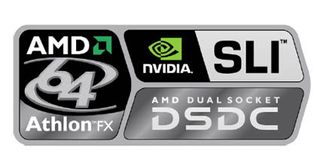AMD launches 4x4 platform Quad FX
Sunnyvale (CA) - AMD today announced availability of its four-core platform knows as "4x4." Called Quad FX, the technology represents the new flagship enthusiast platform from AMD, but it isn't quite the Core 2 Quad beater many expected. It is much more a cutting edge workstation platform - with all advantages and disadvantages.

It's easy, as someone who tries to stay up to date on the newest CPUs, to get excited or disappointed about AMD's 4x4 platform, which has received the commercial name Quad FX. While Intel's recently released quad-core chip Kentsfield is a straightforward quad-core upgrade for enthusiasts who have used single- or dual-core processors so far, Quad FX is likely to become a very polarizing technology, at least initially. If you know what makes it scream, it can unleash tons of horsepower; if you buy it just because it's the latest and greatest, the platform may disappoint.
In its basics, Quad FX does not just relate to new processors, it's actually a platform. It received its own dual-socket motherboard (Asus L1N64-SLI), a new chipset (Nvidia 680a) and new processors. Comparable to an Opteron dual-socket platform, AMD will offer three new Athlon 64 FX processors for Quad FX: The FX-70 (2.6 GHz), FX-72 (2.8 GHz) and FX-74 (3.0 GHz), which use the new socket 1207. While that means that current FX processors (FX-60, FX-62) cannot be used for Quad FX motherboards, AMD said that its upcoming quad-core FX processors (code-named "Agena FX") will continue to use the 1207 socket, which allows users to run up to eight cores in such a system by mid 2007. Reasons for going with a new socket included the addition of Hypertransport lines and allowed AMD to address power consumption requirements of the platform, company representatives told us.
Just in case you are wondering: Yup, Quad FX works only with an Nvidia chipset at this time, despite AMD's recent acquisition of ATI. AMD representatives said that Nvidia's chipset currently is the highest performing chipset, which made the decision for the 680a somewhat easy. AMD declined to comment on a possible Crossfire version for Quad FX but we were told that "this is a very competitive market" and an AMD-branded chipset may become available "rather sooner than later."

4x4 is officially called "Quad FX," but there isn't a "Quad FX" logo. Instead, AMD chose the short cut "DSDC," which stands for dual socket, direct connect".
All three processors are built in 90 nm, use AMD's 2 GHz Hypertransport bus, integrate 2 x 1 MB L2 cache and are rated at a maximum power consumption of 125 watts - or 250 watts for a 2-processor package. AMD declined to comment on future processor versions, but sources told TG Daily that an Athlon 64 FX-76 (3.2 GHz) can be expected to debut early in Q2 2007. Agena FX, which will use a native quad-core, is currently scheduled to launch with clock speeds of 2.7 - 2.9 GHz and a Hypertransport connect that is rated at more than 4 GHz in early Q3 2007.
All that horsepower will buy a lot more performance, according to AMD: Compared to an FX-62 dual-core chip, raytracing may run up to 103% faster, video editing will gain up to 56%, and other multithreaded applications such as Cinebench up to 60%. However, while Intel's Core 2 Extreme QX6700 can excel at almost any discipline, Quad FX systems aren't quite gaming systems, but rather multitasking, or as AMD calls it - "megatasking" - machines. Translation: The more applications you throw at it at the same time, the more you can see the system's capabilities. For example, AMD claims that a Quad FX system can run to demanding games as well as HD video encode and decode at the same time. Such a scenario may not be common today, but software developers always have found a way to make use of available computing power and we have no doubts that Quad FX will be exhausted as well.
Stay on the Cutting Edge
Join the experts who read Tom's Hardware for the inside track on enthusiast PC tech news — and have for over 25 years. We'll send breaking news and in-depth reviews of CPUs, GPUs, AI, maker hardware and more straight to your inbox.
Most Popular

